If you’re looking for a low-maintenance houseplant that also provides a variety of health benefits, aloe vera (Aloe vera) might just be the perfect choice! Aloe is a splendid addition to any home with its striking green leaves. Aloe vera is easy to care for and has properties that provide a myriad of health benefits. Whether you’re a seasoned plant enthusiast or a beginner looking to green up your space, growing aloe is a great way to add some natural beauty and practical benefits to your life. So, grab your gardening gloves, and let’s get started! Keep reading for your complete guide on how to grow aloe vera.
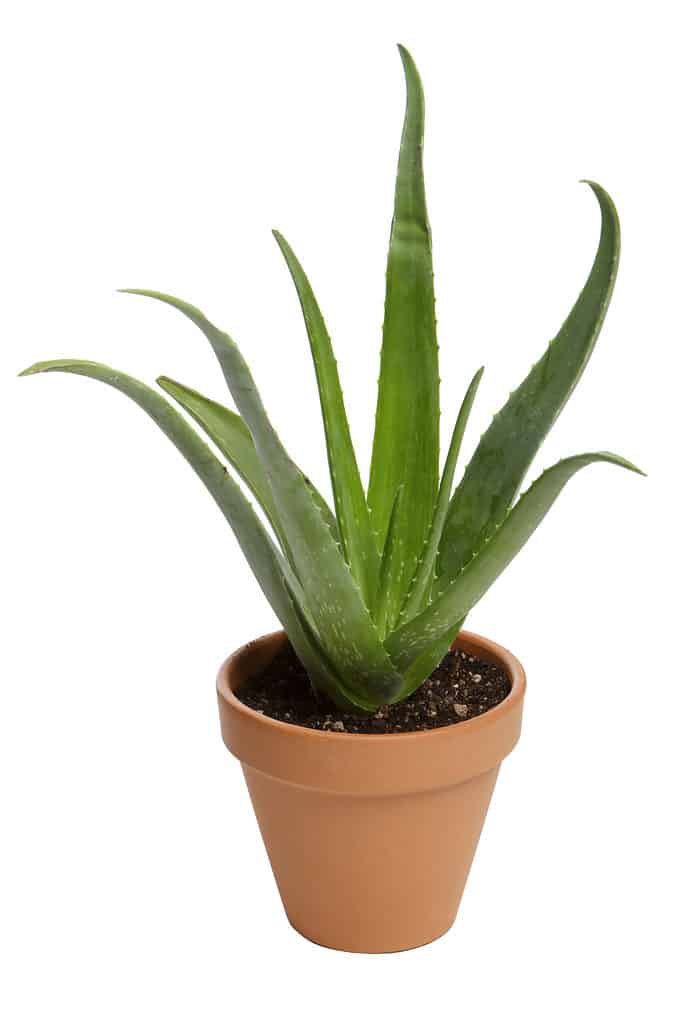
Aloe vera is easy to care for and has properties that provide a myriad of benefits for your skin and health.
©Hurst Photo/Shutterstock.com
What is Aloe Vera?
Aloe vera (Aloe vera) is a succulent plant that belongs to the genus Aloe. It is a perennial plant that grows in warm, dry climates and is known for its fleshy leaves that contain a clear gel-like substance. This gel has been used for centuries for its medicinal properties and is commonly used in skincare and beauty products. Aloe vera is also a popular houseplant due to its ease of care and ability to purify the air. The plant can grow up to three feet tall. Mature plants produce yellow or orange tubular flowers on a tall spike in the summertime. Aloe vera can be grown from the seed produced by these flowers, however, it is more commonly propagated from the offsets (or pups) that are grown at the base of the plant or through root division.

Aloe vera grows in warm, dry climates and is known for its fleshy leaves that contain a clear gel-like substance.
©areeya_ann/Shutterstock.com
While there are nearly 500 species of Aloe, aloe vera specifically refers to the Aloe barbadensis Miller plant, which is the most common type used in aloe-based products. Aloe vera is the most widely recognized and widely cultivated species and is the one most commonly referred to simply as aloe. However, there are a few other species of aloe that are also used for their medicinal properties, including Aloe arborescens, Aloe ferox, and Aloe chinensis. These species have slightly different characteristics and growth habits, but they all share the signature fleshy leaves and gel-like substance that make aloe plants so popular.
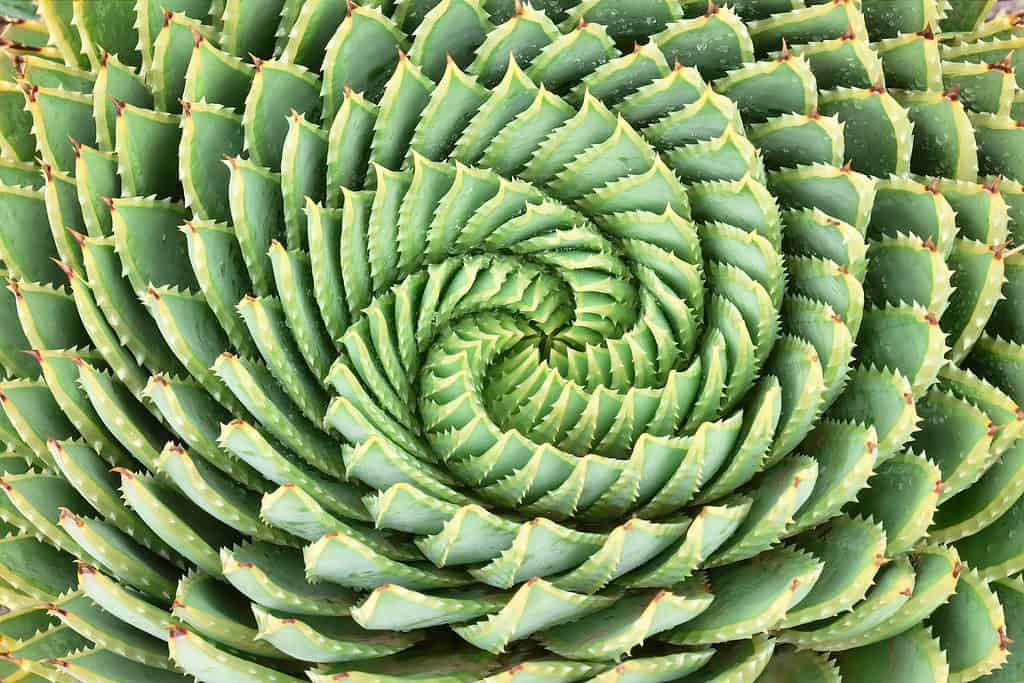
Spiral aloe (
Aloe polyphylla) grows in a spiral formation, with leaves that form a perfect rosette.
©PhotoSky/Shutterstock.com
How to Grow Aloe Vera: Requirements
Aloe vera is a plant that thrives in warm, arid (dry) climates, and it is typically grown outdoors in USDA Hardiness Zones 9-11. These zones have average minimum temperatures that range from which is suitable for aloe vera plants. In these zones, aloe vera can be grown as a perennial plant and can be planted directly in the ground or in a container outdoors. If you live in a colder climate outside of Zones 9-11, you can still grow aloe vera indoors or in a greenhouse, as long as you provide it with the right growing conditions. Discover which USDA Hardiness Zone you call home here.
Aloe vera can survive temperatures as low as 40 degrees Fahrenheit (4 degrees Celsius) for short periods, but it is best to keep the plant in an environment that stays above 50 degrees F (10 degrees C). If the temperature drops below freezing, the plant’s leaves will turn black, and die.
In the United States, aloe vera can be grown outdoors in Florida and California. Aloe vera is a popular landscaping plant in many parts of California, particularly in drier areas such as the Mojave Desert. In Florida, aloe vera can be grown outdoors in the southernmost regions of the state. In colder climates, aloe vera is often grown as a houseplant or in containers that can be moved indoors when the mercury drops.

Aloe Vera is a popular landscaping plant in many parts of California.
©demamiel62/Shutterstock.com
How to Grow Aloe Vera: Methods of Propagation
Aloe vera is a versatile plant that can be grown and propagated by a few specific methods. The principal means are from offsets, by root division, a single leaf, or from seed. Offsets are small plantlets that grow from the base of the mother plant and can be separated and replanted to form a completely separate plant. This is the most common method of propagating aloe vera and is relatively easy to do.
Root division involves separating the mother plant into smaller sections, each with its own roots, which can be replanted to form new plants. This method is more challenging than using offsets, but it can be used to produce a larger plant. Taking a single leaf cutting is another popular method of growing an aloe plant. This method requires more time and can be hit-or-miss for a novice gardener. Finally, aloe vera can be grown from seed. However, growing the plant from seed is tricky, and takes many years.
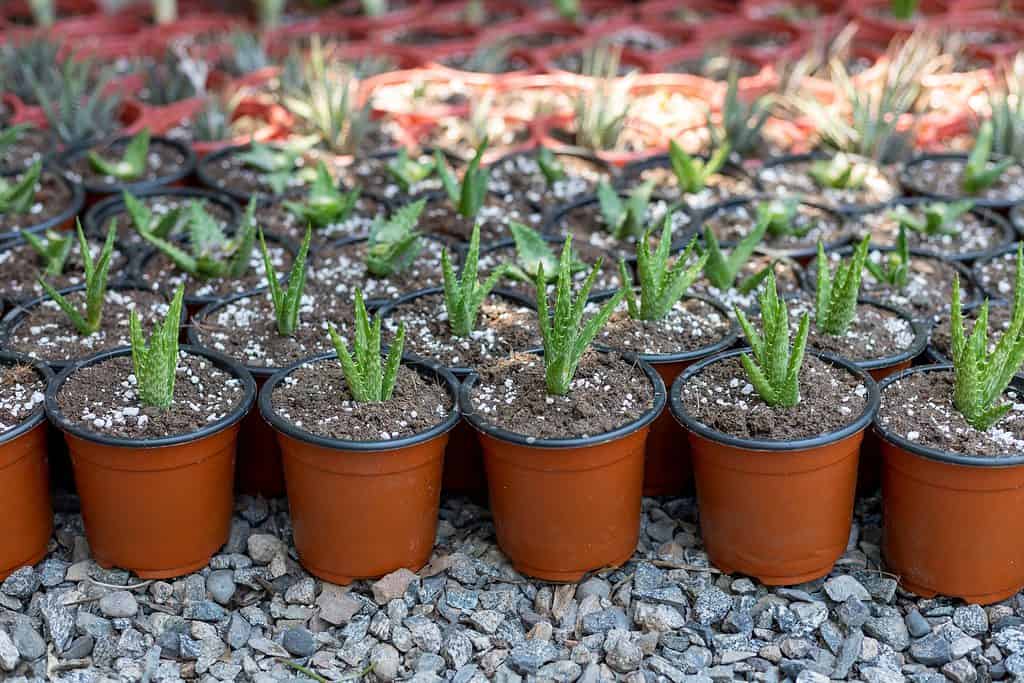
Offsets are small plantlets that grow from the base of the mother plant and can be separated and replanted to form a completely separate plant.
©Bilalstock/Shutterstock.com
Growing Aloe Vera from Offsets
Growing aloe vera from offsets is a simple and effective way to propagate this popular succulent. With the proper care and attention, your aloe vera offsets will grow into healthy, thriving plants.
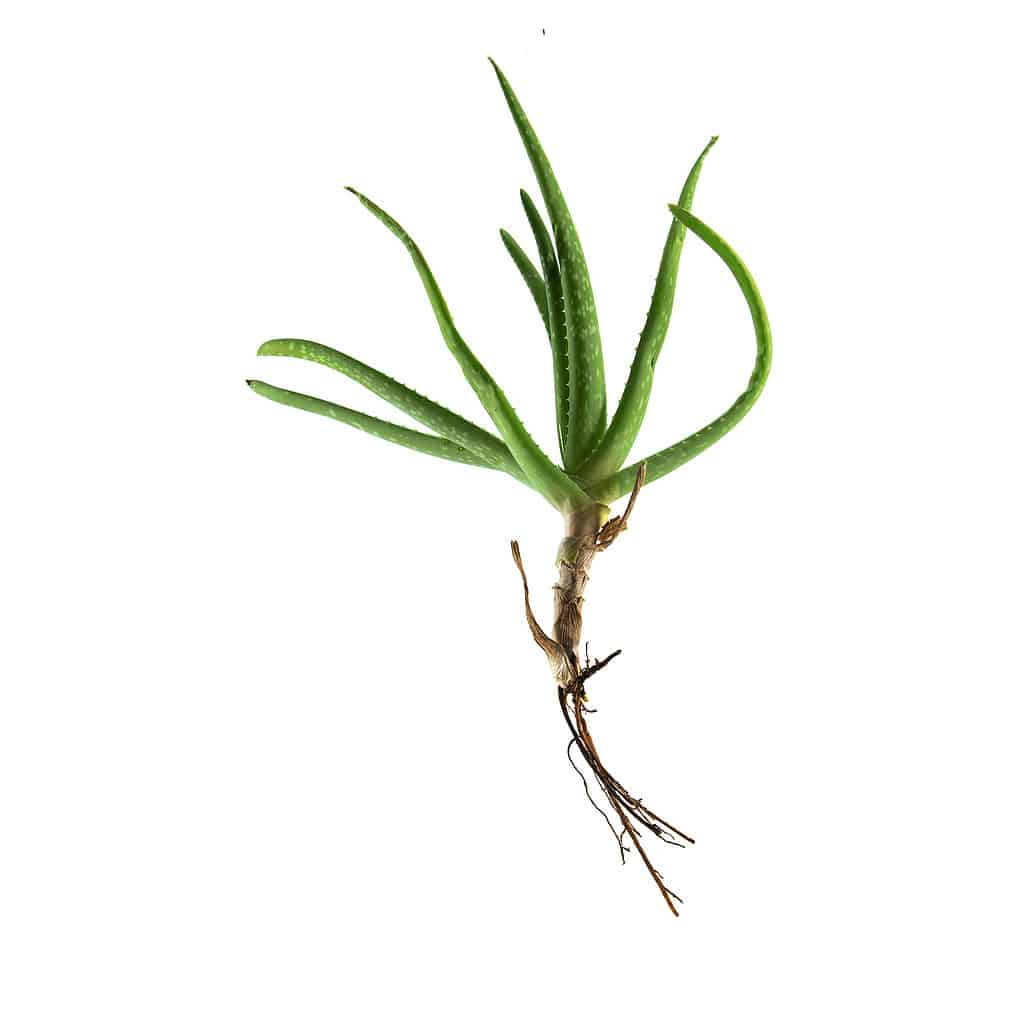
Aloe vera offsets will grow into healthy, thriving plants.
©Maren Winter/Shutterstock.com
Here’s how you can grow aloe vera from offsets:
- Choose a container that is large enough to accommodate the plant’s root system and allow for some growth. A general rule of thumb is to select a container that is one to two inches larger in diameter than the plant’s root ball.
- Fill the pot with a well-draining soil mix designed for cacti or succulents. Alternatively, you can create your own by mixing equal parts of sand, perlite, and potting soil.
- Select a mature aloe vera plant that has several healthy offsets growing at the base of the plant.
- Carefully remove the offset from the parent plant with a sharp, clean knife or scissors. Be sure to cut as close to the parent plant as possible. This will allow for the longest roots of the offset. A clean, sterile knife or scissors helps prevent infecting the mother plant (and the offset) from potential disease. Wiping the knife with alcohol will sterilize it.

With the right care and attention, your aloe vera offsets will grow into healthy, thriving plants.
©iStock.com/cgdeaw
Planting the Offsets
- Plant the offset in the prepared soil. Bury the plant’s roots in the soil and gently tamp the soil around the plant.
- Water the soil thoroughly. Keep the soil evenly moist as the roots take hold. Allow the soil to dry out between waterings as the plant matures. Aloe Vera plants are drought-tolerant and prefer to be kept on the dry side.
- Aloe vera plants require bright, indirect sunlight to thrive. Place the container in a sunny spot or use a grow light if necessary. Though aloe thrives in bright, indirect light, placing your aloe plant in the path of direct sun will cause the leaves to bruise.
- As the plants grow, continue to water them sparingly and provide bright, indirect sunlight. Once they have outgrown their container, you can transplant them into larger containers or separate them into individual pots.
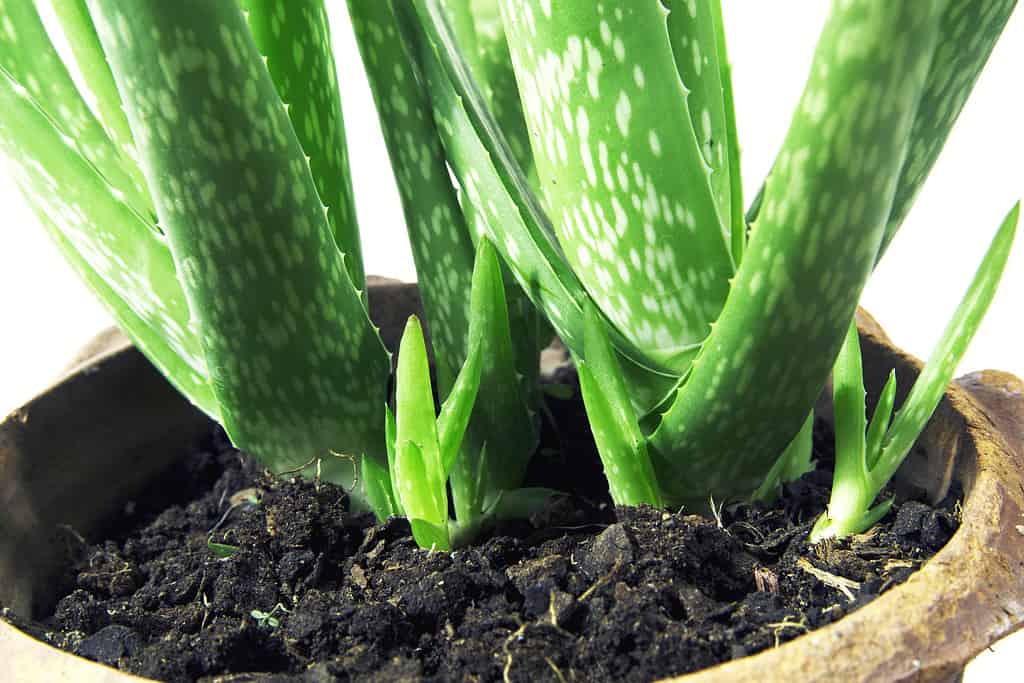
Select a mature aloe vera plant that has several healthy offsets growing at the base of the plant.
©S_Sukporn/Shutterstock.com
Growing Aloe Vera from Root Division
Root division is a viable method for planting aloe vera, particularly for larger plants grown outdoors. However, it can also be used for container-grown plants that have outgrown their current containers. The key is that each division has healthy leaves and roots to ensure successful growth.
Herewith are the steps to plant an aloe plant using root division:
- Select a mature aloe vera plant that has several healthy leaves and a well-established root system.
- Carefully dig up the plant, or remove it from its container. Gently shake off any excess soil to expose the roots. When digging up an aloe plant that is growing in terra firma, cut it a wide berth. Be certain to start your hole a foot or more away from the base of the plant. This will help preserve the entire root ball.
- Using a sharp, clean knife, scissors, or an ax, carefully separate the plant into smaller sections. Ensure that each section has healthy leaves and roots. A sterile cutting implement is essential to avoid spreading disease. Rubbing down your blade with alcohol will sterilize it.
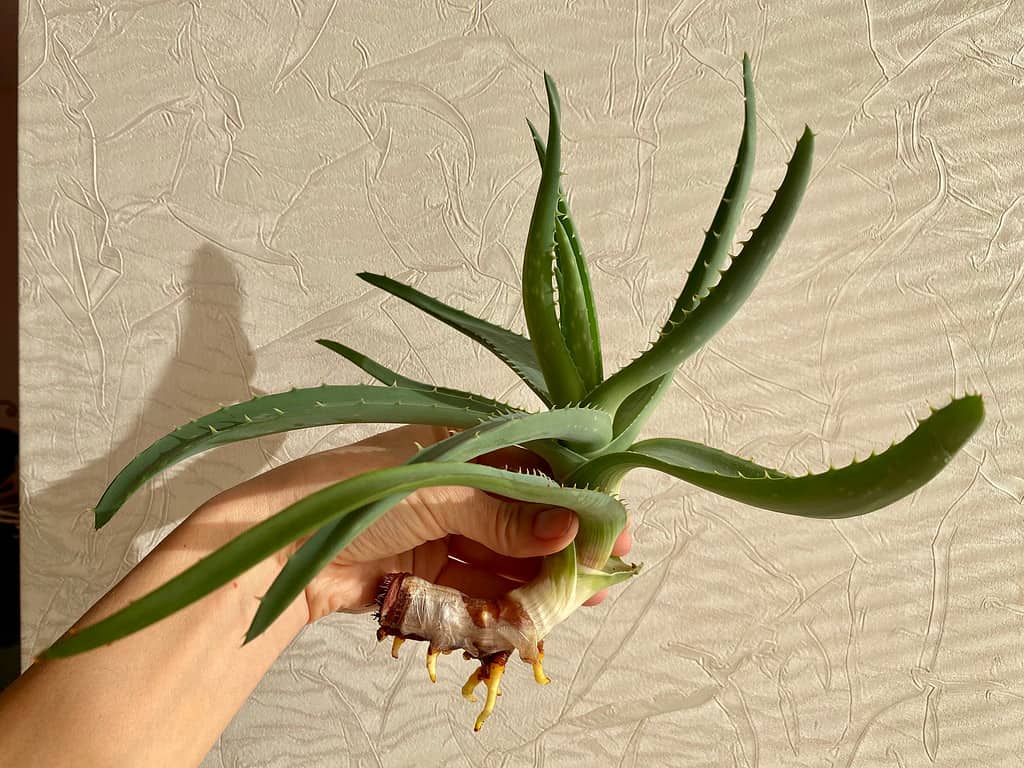
Root division is a viable method for planting aloe vera, particularly for larger plants grown outdoors.
©Mala Iryna/Shutterstock.com
Planting Your Root Division
- Place the largest division into the hole from which the original plant was taken, filling it with soil around its roots, up to the plant’s base. Tamp the soil gently. Dig holes for the remaining divisions that are large enough to accommodate the roots with room for growth. If repotting plants separated by root division, place them in appropriately sized containers with a well-draining soil mix designed for cacti or succulents, or create your own by mixing equal parts of sand, perlite, and potting soil.
- Water the plant thoroughly but avoid overwatering. Keep the soil evenly moist until the plant is established. Once the roots have had a chance to set, allow the planting medium to dry out between waterings. Aloe vera plants are drought-tolerant and prefer to be kept on the dry side.
- Aloe vera plants require bright, indirect sunlight to thrive, so place the container or planting hole in a spot that is bright without receiving direct sun, which can bruise the plant’s leaves.
Growing Aloe Vera from a Leaf Cutting
Not all aloe vera leaves will produce new growth, and the success of this propagation method is not as surefire as by offset or division. Aloe vera grown from a single leaf may take longer to produce a mature plant compared to other propagation methods. However, with patience and care, you can successfully grow new aloe vera plants from single leaves. Here are the steps to grow aloe vera from a single leaf:
- Select a healthy, mature leaf from an established aloe vera plant. Make sure the leaf is free from damage or disease.
- Remove the leaf from the plant using sterile scissors or a knife. Wiping your cutting blade with alcohol will eliminate the possibility of infecting your plant in the process.
- Allow the leaf to dry out until it forms a callus. This will help prevent the leaf from rotting when planted.
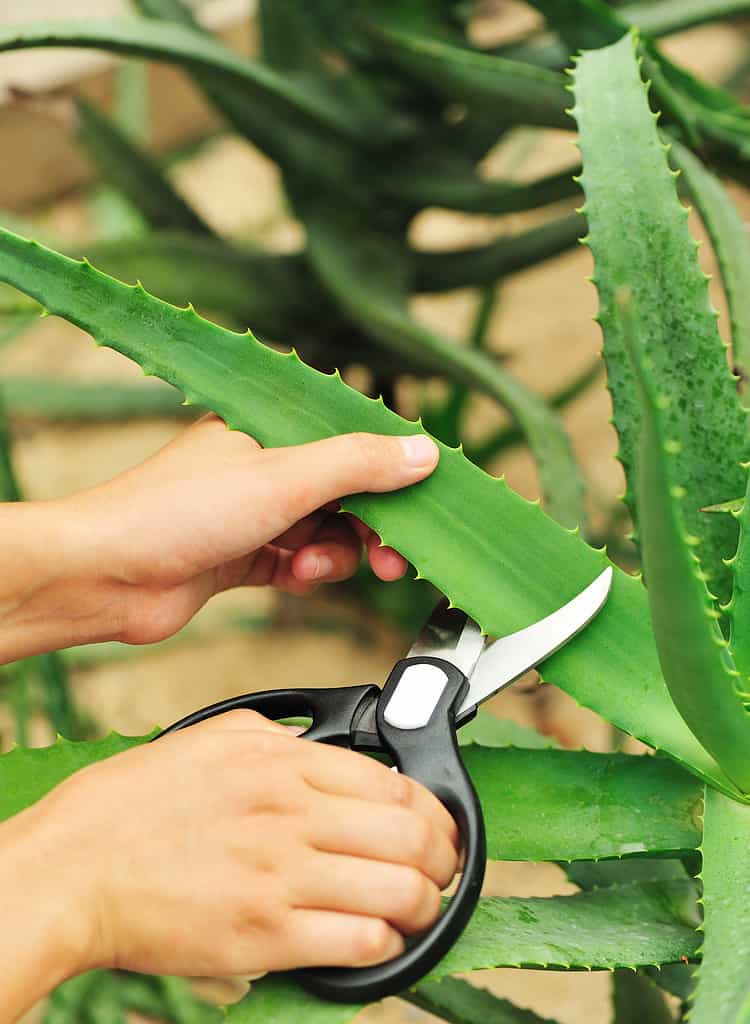
Remove the leaf from the plant using sterile scissors or a knife.
©lzf/Shutterstock.com
Planting Your Leaf Cutting
- Plant the callused leaf about an inch deep in a well-draining soil mix designed for cacti or succulents. Firmly press the soil around the base of the leaf to secure it in place.
- Water the soil thoroughly initially, keeping it evenly moist until the roots have had a chance to set. once the roots are established, allow the soil to dry out between waterings.
- Aloe vera requires bright, indirect sunlight to thrive. If your Aloe vera will be a houseplant, a grow lamp might be necessary.
- After a few weeks, you should start to see new growth from the base of the planted leaf. Once the new growth is established, you can begin to treat the plant as a mature aloe vera plant.

Three callused Aloe Vera leaves ready for planting.
©Chad Zuber/Shutterstock.com
Growing Aloe Vera from Seed
While it is possible to grow aloe vera from seed, this method is by far the trickiest and most time. consuming. However, if you are the patient type who is often up for a challenge, then growing aloe vera from seed might be right up your alley. To grow a thriving aloe plant from seed:
- Obtain seeds: If you’re a super-patient person, you can produce your own aloe vera seed. Just be aware that it takes 4-11 years for an aloe vera plant to produce viable seed. The easier route is purchasing aloe vera seeds online or from a nursery.
- Choose a container: Select a container with drainage holes in the bottom and fill it with a well-draining soil mix specifically designed for cacti or succulents, or create your own by mixing equal parts of sand, perlite, and potting soil.
- Sow the seeds: Sow the aloe vera seeds on the soil surface and press them gently into the soil. Do not cover them with soil, as they require light to germinate.
- Water the soil gently to settle the seeds into the soil, being careful not to disturb them. Keep the soil evenly moist.
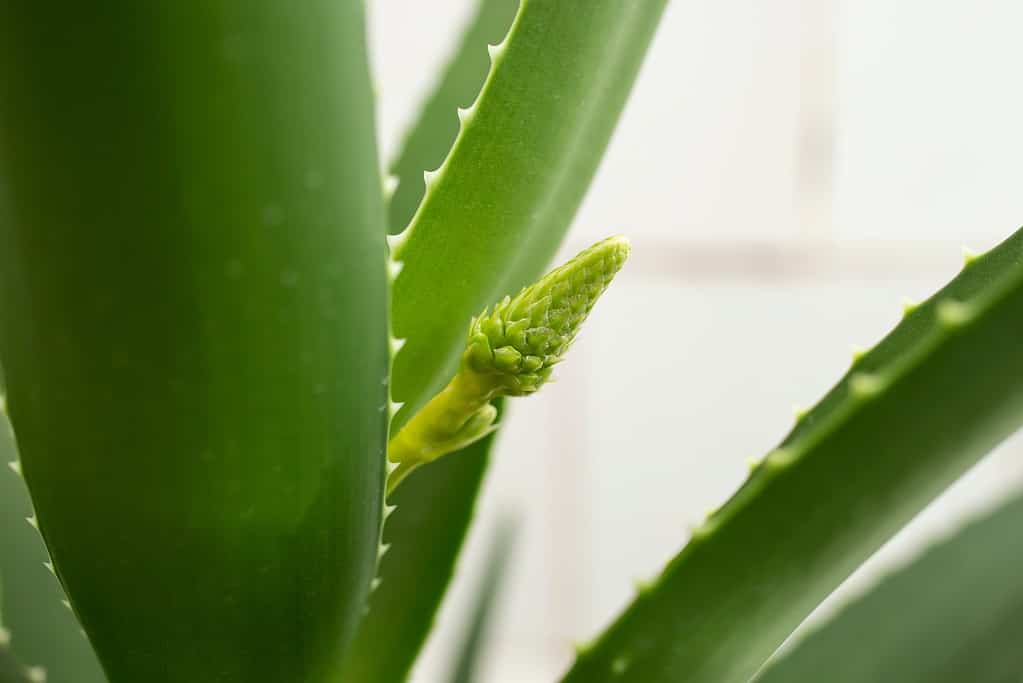
Aloe Vera seed comes from the aloe vera flower, which takes 4-11 years for an Aloe Vera plant to produce.
©puha dorin/Shutterstock.com
Caring for Your Seedlings
- Provide light: Aloe vera seeds require bright, indirect sunlight to germinate, so place the container in a spot that receives several hours of sunlight per day or use a grow light.
- Wait for germination: Aloe vera seeds can take several weeks to germinate, so be patient and keep the soil moist and in a warm location.
- Care for the seedlings: Once the seedlings have emerged, continue to provide bright, indirect sunlight and keep the soil moist. Once the seedlings have established a few true leaves, you can transplant them into individual pots.
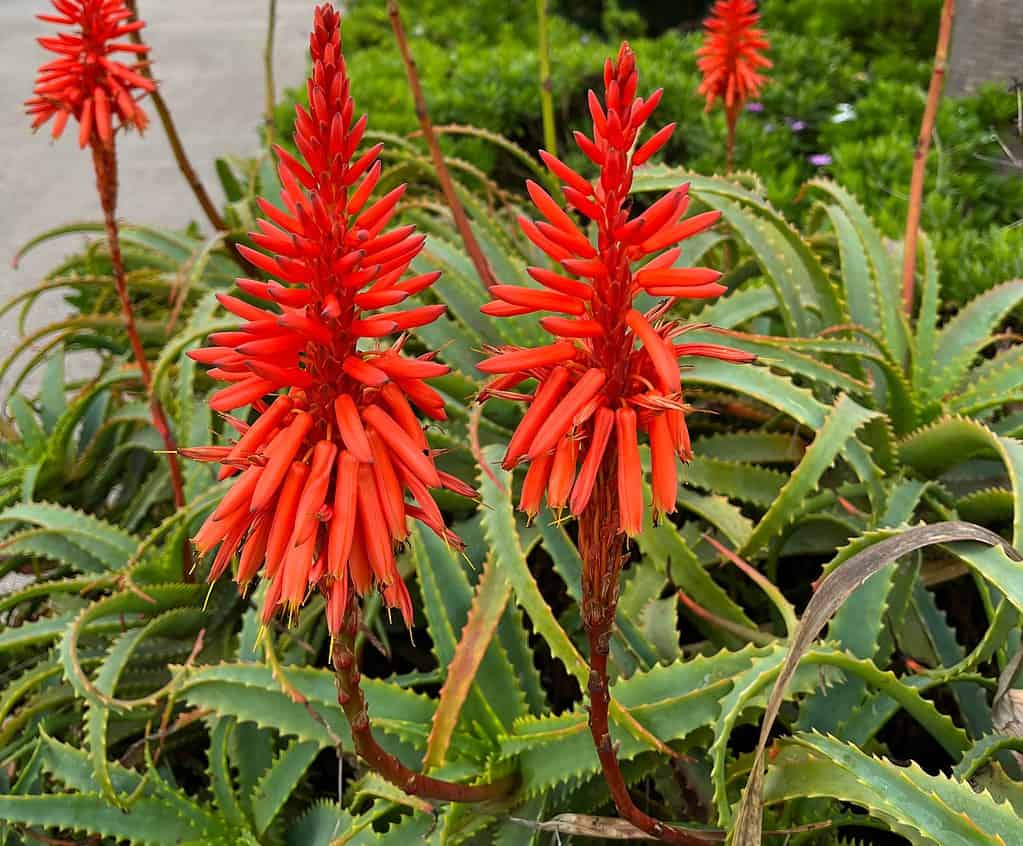
Individual aloe vera plants have been known to survive for as long as 100 years in the wild!
©Alex_o_photography/Shutterstock.com
Five Fabulous Facts about Aloe Vera
- Aloe vera is native to the Arabian Peninsula, but it can now be found growing in tropical and subtropical regions around the world.
- Aloe vera has been used for medicinal purposes for thousands of years and is still widely used today for its healing properties. The gel inside the aloe vera leaves, while 96% water, contains vitamins, minerals, and amino acids that soothe and heal skin conditions such as burns, cuts, and sunburns.
- Egyptian Queen Cleopatra reportedly used aloe vera as a skin moisturizer. Christopher Columbus and Alexander the Great reportedly used the plant’s gel to treat wounds. There is now evidence that points toward aloe vera’s antiseptic properties.
- Individual aloe vera plants have been known to survive for as long as 100 years in the wild!
- Aloe vera gel makes a dandy tooth cleanser that is as effective as toothpaste in preventing cavities!
Thank you for reading! Have some feedback for us? Contact the AZ Animals editorial team.








